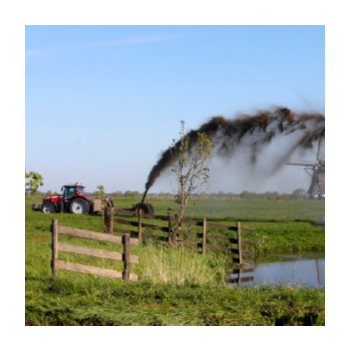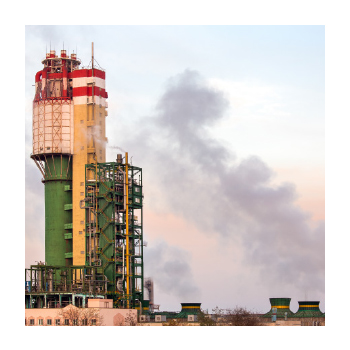


Sign-up for {N}power to get exclusive discounts, newsletters, members-only features, and more!

If industrial pollution in your neighborhood killed hundreds of fish in your river, tripled your water bills, was linked to an increased risk for congenital disabilities, bladder cancer, and hyperthyroidism, and spewed fine particulate matter (PM2.5)—an air pollutant that can deposit deep in your lungs—would you demand change?1 This is precisely what communities nearby and downstream from concentrated animal feeding operations (CAFOs) are experiencing.2 3
One large CAFO can produce as much manure as a city like Lake Tahoe, California produces in sewage and the largest operations collectively produce 335 million tons of manure every year.4 CAFO waste is typically untreated and contains hazardous substances, including pathogens, pharmaceuticals, and nitrates.5 6 7 As it piles up in barns, feedlots, and storage pits, it needs somewhere to go. So, where, exactly, would that be?
The most convenient method for CAFO waste disposal is spreading it on farm fields as fertilizer, but the sheer volume is often more than crops can handle. Manure contains nitrogen and phosphorus, nutrients plants need to grow, but they become pollutants in excess.8 According to a Union of Concerned Scientists Report, “one half of all nitrogen applied to crops is lost to air, soil, and water.” It estimates that in 2017 alone, 800 million pounds of nitrogen from fertilizer applications in Iowa (where there are nearly 4,000 CAFOs) ended up in waterways.9 10 Nutrient runoff is linked to harmful algal blooms, making water uninhabitable for fish and other aquatic life.11 12 And since 1980, the damages caused by nitrogen pollution from Midwest farms to marine habitats and local economies in the Gulf of Mexico have amounted to as much as $2.4 billion annually.13
 Wet manure management systems, widely used in swine and dairy operations, also contribute significantly to CAFO pollution. These systems transport liquid waste through pipes and store them in pits or tanks prone to rupture or overflow.14 A 2018 pipe break at a Michigan dairy CAFO, for example, flooded a popular trout fishing stream with approximately 10,000 gallons of waste.15 And throughout the years, such spills have been linked to large-scale fish kills, including when waste from a Minnesota hog facility annihilated an estimated 700,000 fish when it washed into Beaver Creek. Meanwhile, two years after runoff from manure applied to Illinois fields impaired 20 miles of stream, nine species of fish vanished from the area.16 Additionally, CAFO waste is a source of nitrate pollution in drinking water, which is associated with adverse health effects, including congenital disabilities, an increased risk of some cancers, and thyroid issues.17 18
Wet manure management systems, widely used in swine and dairy operations, also contribute significantly to CAFO pollution. These systems transport liquid waste through pipes and store them in pits or tanks prone to rupture or overflow.14 A 2018 pipe break at a Michigan dairy CAFO, for example, flooded a popular trout fishing stream with approximately 10,000 gallons of waste.15 And throughout the years, such spills have been linked to large-scale fish kills, including when waste from a Minnesota hog facility annihilated an estimated 700,000 fish when it washed into Beaver Creek. Meanwhile, two years after runoff from manure applied to Illinois fields impaired 20 miles of stream, nine species of fish vanished from the area.16 Additionally, CAFO waste is a source of nitrate pollution in drinking water, which is associated with adverse health effects, including congenital disabilities, an increased risk of some cancers, and thyroid issues.17 18
Environmental advocacy groups have long been calling on the EPA to increase its regulation of CAFO pollution. According to a legal petition filed by the non-profit Earth Justice, the "EPA admits that many CAFOs currently discharge water pollution” without permits required by the Clean Water Act. Despite an estimated 21,000-plus large CAFOs in the U.S., only around 6,200 have National Pollutant Discharge Elimination System (NPDES) permits.19 NPDES permits make operations liable for penalties if they violate state and federal clean water standards and provide the public with information and a legal path for enforcement of permit conditions.20
Despite an estimated 21,000-plus large CAFOs in the U.S., only around 6,200 have National Pollutant Discharge Elimination System (NPDES) permits.19
 The waste from CAFOs also emit toxic air pollutants, including ammonia, hydrogen sulfide, and PM2.5. The EPA has developed emissions estimating methodologies (EEMs) for many industries to monitor their air pollution, but it has never finalized EEMs for CAFOs, which cripples its ability to hold this industry accountable.21 22 Complicating matters is the inconsistent and severely lacking data the EPA and state agencies have on CAFOs in general. And, perhaps most concerning, a decade-long National Resources Defense Council investigation found that the EPA has "less information about waste management practices than for any other (CAFO) data category."23
The waste from CAFOs also emit toxic air pollutants, including ammonia, hydrogen sulfide, and PM2.5. The EPA has developed emissions estimating methodologies (EEMs) for many industries to monitor their air pollution, but it has never finalized EEMs for CAFOs, which cripples its ability to hold this industry accountable.21 22 Complicating matters is the inconsistent and severely lacking data the EPA and state agencies have on CAFOs in general. And, perhaps most concerning, a decade-long National Resources Defense Council investigation found that the EPA has "less information about waste management practices than for any other (CAFO) data category."23
Pasture-based, regenerative, and organic animal food production systems, by design, don't recklessly externalize costs onto the wellbeing of neighboring communities and ecosystems. The agency tasked with protecting our precious resources hasn't been up to the task—are our menu choices?



Sign-up for {N}power to get exclusive discounts, newsletters, members-only features, and more!